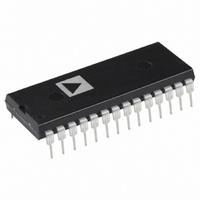AD1674KNZ Analog Devices Inc, AD1674KNZ Datasheet - Page 9

AD1674KNZ
Manufacturer Part Number
AD1674KNZ
Description
IC ADC 12BIT 100KSPS 28-DIP
Manufacturer
Analog Devices Inc
Specifications of AD1674KNZ
Data Interface
Parallel
Number Of Bits
12
Sampling Rate (per Second)
100k
Number Of Converters
1
Power Dissipation (max)
825mW
Voltage Supply Source
Dual ±
Operating Temperature
0°C ~ 70°C
Mounting Type
Through Hole
Package / Case
28-DIP (0.600", 15.24mm)
Resolution (bits)
12bit
Sampling Rate
100kSPS
Input Channel Type
Single Ended
Supply Voltage Range - Digital
4.5V To 5.5V
Supply Current
14mA
Digital Ic Case Style
DIP
Number Of Elements
1
Resolution
12Bit
Architecture
SAR
Sample Rate
100KSPS
Input Polarity
Unipolar/Bipolar
Input Type
Voltage
Rated Input Volt
10/20/±5/±10V
Differential Input
No
Power Supply Requirement
Dual
Single Supply Voltage (typ)
Not RequiredV
Single Supply Voltage (min)
Not RequiredV
Single Supply Voltage (max)
Not RequiredV
Dual Supply Voltage (typ)
±12/±15V
Dual Supply Voltage (min)
±11.4V
Dual Supply Voltage (max)
±16.5V
Power Dissipation
575mW
Integral Nonlinearity Error
±0.5LSB
Operating Temp Range
0C to 70C
Operating Temperature Classification
Commercial
Mounting
Through Hole
Pin Count
28
Package Type
PDIP W
Input Signal Type
Single-Ended
Lead Free Status / RoHS Status
Lead free / RoHS Compliant
Lead Free Status / RoHS Status
Lead free / RoHS Compliant, Lead free / RoHS Compliant
Available stocks
Company
Part Number
Manufacturer
Quantity
Price
Company:
Part Number:
AD1674KNZ
Manufacturer:
Analog Devices Inc
Quantity:
135
Part Number:
AD1674KNZ
Manufacturer:
ADI/亚德诺
Quantity:
20 000
REV. C
Figure 5. Harmonic Distortion vs.
Input Frequency
GENERAL CIRCUIT OPERATION
The AD1674 is a complete 12-bit, 10 s sampling analog-to-
digital converter. A block diagram of the AD1674 is shown on
page 7.
When the control section is commanded to initiate a conversion
(as described later), it places the sample-and-hold amplifier
(SHA) in the hold mode, enables the clock, and resets the suc-
cessive approximation register (SAR). Once a conversion cycle
has begun, it cannot be stopped or restarted and data is not
available from the output buffers. The SAR, timed by the inter-
nal clock, will sequence through the conversion cycle and return
an end-of-convert flag to the control section when the conver-
sion has been completed. The control section will then disable
the clock, switch the SHA to sample mode, and delay the STS
LOW going edge to allow for acquisition to 12-bit accuracy.
The control section will allow data read functions by external
command anytime during the SHA acquisition interval.
During the conversion cycle, the internal 12-bit, 1 mA full-scale
current output DAC is sequenced by the SAR from the most
significant bit (MSB) to the least significant bit (LSB) to pro-
vide an output that accurately balances the current through the
5 k resistor from the input signal voltage held by the SHA.
The SHA’s input scaling resistors divide the input voltage by 2
for the 10 V input span and by 4 V for the 20 V input span,
maintaining a 1 mA full-scale output current through the 5 k
resistor for both ranges. The comparator determines whether
the addition of each successively weighted bit current causes the
Figure 8. Nonaveraged 2048 Point FFT
at 100 kSPS, f
–100
–120
–100
–120
–140
–20
–40
–60
–80
–20
–40
–60
–80
0
0
1
0
5
INPUT FREQUENCY – kHz
10
10
IN
= 25.049 kHz
15
FREQUENCY – kHz
FULL-SCALE = +10V
f
SAMPLE
100
20
THD
2
ND
25
= 100kSPS
HARMONIC
1000
HARMONIC
30
3
35
RD
10000
40
45
Figure 6. S/(N+D) vs. Input Frequency
and Amplitude
50
80
70
60
50
40
30
20
10
0
1
–100
–110
–120
–130
–10
–20
–30
–40
–50
–60
–70
–80
–90
–60dB INPUT
–20dB INPUT
0
0dB INPUT
0
10
INPUT FREQUENCY – kHz
5
Figure 9. IMD Plot for f
100
–9–
Typical Dynamic Performance–AD1674
DAC current sum to be greater than or less than the input cur-
rent. If the sum is less, the bit is left on; if more, the bit is
turned off. After testing all the bits, the SAR contains a 12-bit
binary code which accurately represents the input signal to
within 1/2 LSB.
CONTROL LOGIC
The AD1674 may be operated in one of two modes, the full-
control mode and the stand-alone mode. The full-control mode
utilizes all the AD1674 control signals and is useful in systems
that address decode multiple devices on a single data bus. The
stand-alone mode is useful in systems with dedicated input ports
available and thus not requiring full bus interface capability.
Table I is a truth table for the AD1674, and Figure 10 illus-
trates the internal logic circuitry.
CE CS
0
X
1
1
1
1
1
10
1000
X
1
0
0
0
0
0
15
10000
R/C
X
X
0
0
1
1
1
Table I. AD1674A Truth Table
20
FREQUENCY – kHz
12/8 A
X
X
X
X
1
0
0
IN
Figure 7. S/(N+D) vs. Input Amplitude
= 9.08 kHz (fa), 9.58 kHz (fb)
25
X
X
0
1
X
0
1
0
Operation
None
None
Initiate 12-Bit Conversion
Initiate 8-Bit Conversion
Enable 12-Bit Parallel Output
Enable 8 Most Significant Bits
Enable 4 LSBs +4 Trailing Zeroes
30
35
40
45
50













